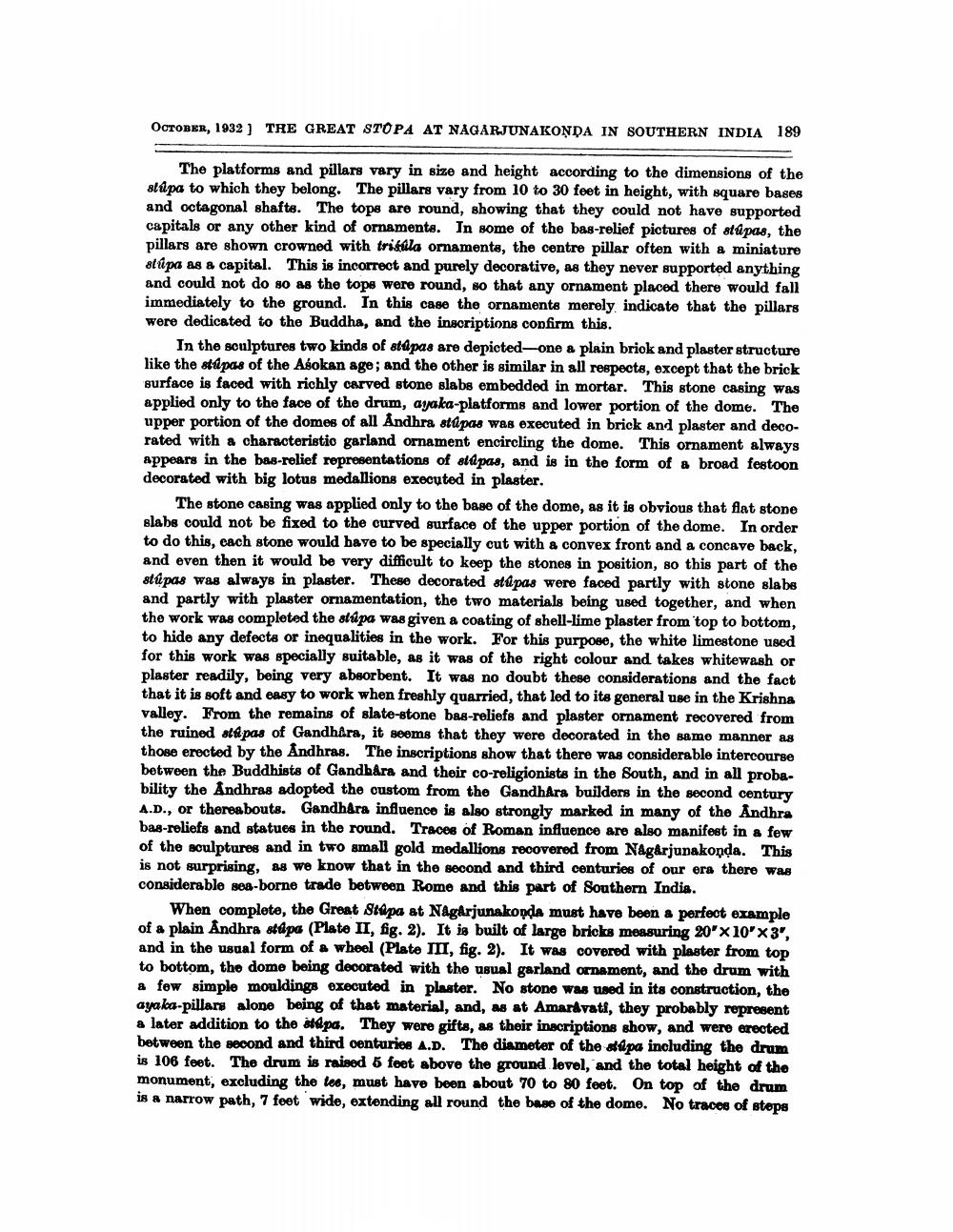________________
OCTOBER, 1932) TRE GREAT STOPA AT NAGARJUNAKONDA IN SOUTHERN INDIA 189
The platforms and pillars vary in size and height according to the dimensions of the stúpa to which they belong. The pillars vary from 10 to 30 feet in height, with square bases and octagonal shafte. The tops are round, showing that they could not have supported capitals or any other kind of ornaments. In some of the bas-relief pictures of stúpas, the pillars are shown crowned with tricula ornaments, the centre pillar often with a miniature stúpa as a capital. This is incorrect and purely decorative, as they never supported anything and could not do 80 as the tops were round, so that any ornament placed there would fall immediately to the ground. In this case the ornaments merely indicate that the pillars were dedicated to the Buddha, and the inscriptions confirm this.
In the soulptures two kinds of stápas are depicted-one a plain briok and plaster structure like the stápas of the Asokan age; and the other is similar in all respects, except that the brick surface is faced with richly carved stone slabs embedded in mortar. This stone casing was applied only to the face of the drum, ayaka-platforms and lower portion of the dome. The upper portion of the domes of all Andhra stúpas was executed in brick and plaster and decorated with a characteristio garland ornament encircling the dome. This ornament always appears in the bas-relief representations of eldpas, and is in the form of a broad festoon decorated with big lotus medallions executed in plaster.
The stone casing was applied only to the base of the dome, as it is obvious that flat stone slabe could not be fixed to the curved surface of the upper portion of the dome. In order to do this, each stone would bave to be specially cut with a convex front and a concave back, and even then it would be very difficult to keep the stones in position, so this part of the stúpas was always in plaster. These decorated stupas were faced partly with stone slabs and partly with plaster ornamentation, the two materials being used together, and when the work was completed the stúpa was given a coating of shell-lime plaster from top to bottom, to hide any defects or inequalities in the work. For this purpose, the white limestone used for this work was specially suitable, as it was of the right colour and takes whitewash or plaster readily, being very absorbent. It was no doubt these considerations and the fact that it is soft and easy to work when freshly quarried, that led to its general use in the Krishna valley. From the remains of slate-stone bas-reliefs and plaster ornament recovered from the ruined at pas of Gandhára, it seems that they were decorated in the same manner as those erected by the Andhras. The inscriptions show that there was considerable intercourse between the Buddhists of Gandh&ra and their co-religionists in the South, and in all probability the Andhras adopted the custom from the GandhAra builders in the second century A.D., or thereabouts. Gandh&ra influence is also strongly marked in many of the Andhra bas-reliefs and statues in the round. Traces of Roman influence are also manifest in a few of the sculptures and in two small gold medallions recovered from Nagarjunakonda. This is not surprising, 88 we know that in the second and third centuries of our era there was considerable sea-borne trade between Rome and this part of Southern India.
When complete, the Great Stupa at Nagarjunakonda must have been a perfect example of a plain Andhra stúpa (Plate II, fig. 2). It is built of large bricks measuring 20'x 10' 3', and in the usual form of a wheel (Plate III, fig. 2). It was covered with plaster from top to bottom, the dome being decorated with the usual garland ornament, and the drum with & fow simple mouldings executed in plaster. No stone was used in its construction, the ayaka-pillars alone being of that material, and, as at Amaravati, they probably represent a later addition to the adpa. They were gifts, as their inscriptions show, and were erected between the second and third centuries A.D. The diameter of the aipa including the drum is 106 feet. The drum is raised 6 foot above the ground level, and the total height of the monument, excluding the tee, must have been about 70 to 80 feet. On top of the drum is a narrow path, 7 feet wide, extending all round the base of the dome. No traces of steps




